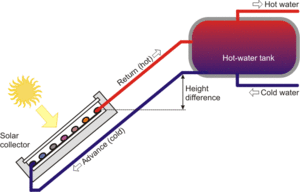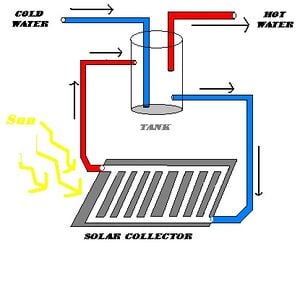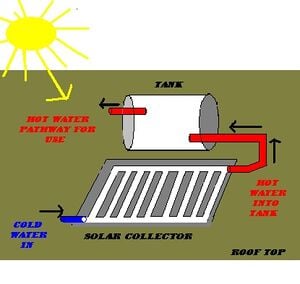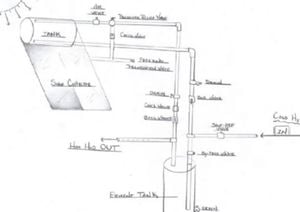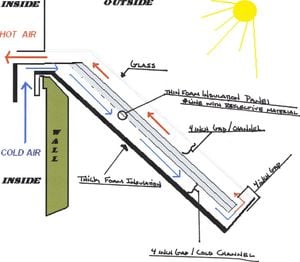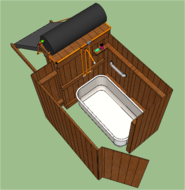La termosifón , también conocida como termosifón , se considera una tecnología adecuada . Este proceso utiliza recursos naturales renovables y las leyes básicas de la termodinámica para crear movimiento de un suministro calentado de aire o agua. La fuente de energía para este proceso es la radiación solar (o cualquier otra fuente de calor). La energía del sol se captura en un dispositivo de recolección solar y se transfiere al aire o al agua mediante conducción. Todo el proceso puede explicarse por el efecto termosifón : cuando el aire o el agua se calientan, obtienen energía cinética de la fuente de calor y se excitan. Como resultado, el agua se vuelve menos densa, se expande y, por tanto, asciende. Por el contrario, cuando se enfría el agua o el aire, se extrae energía de las moléculas y el agua se vuelve menos activa, más densa y tiende a "hundirse". El termosifón aprovecha las diferencias naturales de densidad entre los fluidos fríos y calientes y las controla en un sistema que produce un movimiento natural del fluido. Actualmente se encuentran disponibles varios sistemas basados en esta tecnología, y se puede leer sobre ellos con mayor detalle en el siguiente texto.
El principio del sistema termosifón es que el agua fría tiene una gravedad específica (densidad) más alta que el agua tibia, por lo que al ser más pesada se hundirá. Por lo tanto, el colector siempre se monta debajo del tanque de almacenamiento de agua, de modo que el agua fría del tanque llegue al colector a través de una tubería de agua descendente. Si el colector calienta el agua, el agua vuelve a subir y llega al tanque a través de una tubería de agua ascendente en el extremo superior del colector. El ciclo de tanque → tubería de agua → colector asegura que el agua se caliente hasta que alcance una temperatura de equilibrio. El consumidor puede entonces hacer uso del agua caliente de la parte superior del tanque, y el agua utilizada se reemplaza por agua fría en el fondo. A continuación, el colector vuelve a calentar el agua fría. Debido a mayores diferencias de temperatura con irradiancias solares más altas, el agua caliente aumenta más rápido que con irradiancias más bajas. Por tanto, la circulación del agua se adapta casi perfectamente al nivel de irradiación solar. El tanque de almacenamiento de un sistema termosifón debe colocarse muy por encima del colector; de lo contrario, el ciclo puede retroceder durante la noche y toda el agua se enfriará. Además, la bicicleta no funciona correctamente con diferencias de altura muy pequeñas. En regiones con alta irradiación solar y arquitectura de tejados planos, los depósitos de almacenamiento suelen instalarse en el tejado.
Los sistemas termosifón funcionan de forma muy económica como sistemas de calentamiento de agua sanitaria. El principio es simple y no necesita bomba ni control. Sin embargo, los sistemas de termosifón no suelen ser adecuados para sistemas grandes, es decir, aquellos con más de 10 m² de superficie de captadores. Además, en edificios con tejados inclinados es difícil colocar el depósito encima del colector y los sistemas termosifón de circuito único sólo son adecuados para zonas sin heladas.
Contenido
Física subyacente
La termodinámica es el estudio de la energía .
- Primera ley de la termodinámica : establece que la energía puede transformarse de una forma a otra, pero no puede crearse ni destruirse. La energía siempre se conserva.
Esta ley se puede aplicar al movimiento del agua en un sistema de termosifón: la energía del sol se dirige y transfiere (vía conducción y convección) al agua, al aire u otro medio de elección. Este proceso natural de calentamiento elimina la necesidad de fuentes de energía externas como combustibles fósiles o electricidad.
- Segunda ley de la termodinámica : establece que en todos los intercambios de energía, si no entra ni sale energía del sistema, la energía potencial del estado siempre será menor que la del estado inicial. El rendimiento neto de un sistema es siempre menor que el del que se instaló inicialmente.
La energía siempre se conserva; sin embargo, la energía (o calor en este caso) a menudo puede perderse en forma de calor en un sistema determinado (termosifón). Agregar aislamiento con valores R apropiados al sistema y sus tuberías puede reducir en gran medida la pérdida de calor y, por lo tanto, aumentar la eficiencia.
- Ley de Planck : la longitud de onda de la radiación emitida por una superficie es proporcional a la temperatura de la superficie. Energía transferida como resultado de diferencias de temperatura entre dos objetos. Los objetos oscuros absorben calor, mientras que los objetos claros lo reflejan.
Las placas colectoras de colores oscuros dentro del colector solar ayudarán a aumentar la absorción solar, aumentando así la cantidad de calor disponible para calentar agua o aire en termosifón. Por el contrario, se deben utilizar tuberías y tanques de almacenamiento reflectantes o de colores claros, ya que los colores claros ayudarán a reducir la radiación de calor que sale del sistema.
Calentamiento pasivo de agua
El termosifón pasivo de agua es el proceso de calentar y mover agua dentro de un sistema sin necesidad ni uso de electricidad. Este proceso funciona utilizando fenómenos naturales como la energía solar, la gravedad y una fuente de agua disponible. Un colector solar , tuberías y un tanque de agua son materiales necesarios para el proceso de calefacción. El flujo de agua se distribuye dentro, dentro y fuera del colector solar. El agua fría ingresa al fondo del colector solar donde luego se calienta por convección mediante radiación solar. Cuando el agua se calienta, se vuelve menos densa que el agua más fría, se expande y luego asciende ( fluye ) a través de las tuberías. El agua calentada sale naturalmente por la parte superior del colector solar. El agua más fría y densa se hunde y permanece dentro del colector solar hasta que se calienta. A medida que el agua fría se calienta, se expande, se eleva y es empujada hacia afuera de la parte superior del colector solar, lo que permite que el agua fría fluya hacia el colector solar. Este proceso continúa de forma natural hasta que la temperatura del agua alcanza un equilibrio con la entrada de radiación solar.
Actualmente se encuentran disponibles dos tipos de sistemas de intercambio de agua por termosifón: el sistema de acoplamiento cerrado y el sistema de alimentación por gravedad.
Sistema monobloc
Los sistemas estrechamente acoplados funcionan según los mismos principios de termosifón pasivo mencionados anteriormente. El tanque de almacenamiento de estos sistemas debe colocarse encima del colector solar para utilizar la circulación de agua impulsada por el proceso de termosifón pasivo.
Materiales
- Energía solar
- Batería solar
- Tubería
- Aislamiento
- Agua
- Tanque de almacenamiento
- Techo fuerte u otro sistema de soporte
Costo
- Una investigación de 2007 sugiere que los calentadores de agua por termosifón pasivos pueden costar entre $ 500 y $ 6500. El precio puede variar según el tamaño del tanque, la exposición solar y la ubicación geográfica.
- Muchos países, estados y servicios públicos ofrecen incentivos para la participación en energías renovables.
Ventajas
- No contaminante
- Ahorro de energía: no se necesita electricidad para el termosifón pasivo
- Económico
- Ahorro de espacio (es decir, en interiores)
Contras
- La exposición del tanque a condiciones ambientales externas puede reducir la eficiencia, dependiendo de la ubicación geográfica.
- Estética: puede considerarse visualmente desagradable.
- Se necesita una estructura de soporte fuerte (es decir, techo)
- No apto para climas extremadamente fríos.
- Ubicación: debe ubicarse en un área con exposición solar adecuada (es decir, el lado sur del área deseada)
Sistema de alimentación por gravedad
Los sistemas de alimentación por gravedad utilizan los mismos principios de termosifón pasivo que el sistema de acoplamiento cerrado, sin embargo, la ubicación del tanque difiere. Los tanques se instalan horizontalmente en un techo, que a menudo se encuentra directamente encima del colector solar. Una vez necesaria, el agua calentada dentro del tanque de almacenamiento toma el camino de menor resistencia y se mueve por gravedad hacia la ubicación deseada. Los sistemas de alimentación por gravedad requieren más tuberías/plomerías para distribuir el agua calentada, y este factor debe tenerse en cuenta al instalar o comprar un sistema de termosifón.
Materiales
- Energía solar
- Batería solar
- Tubería
- Aislamiento
- Agua
- Tanque de almacenamiento
- Techo fuerte u otro sistema de soporte
Costo
- Los sistemas de alimentación por gravedad suelen ser los calentadores de agua por termosifón pasivos más económicos.
- Una investigación de 2007 sugiere que el costo puede oscilar entre $400 y $5,500 (sin incluir el costo -si corresponde- de instalación). El precio puede variar según el tamaño del tanque, la exposición solar y la ubicación geográfica.
- Muchos países, estados y servicios públicos ofrecen incentivos para la participación en energías renovables.
Ventajas
- No contaminante
- Ahorro de energía: no se necesita electricidad para el termosifón pasivo
- Económico
- Ahorro de espacio (es decir, en interiores)
- Estética - (Colocación del tanque horizontal)
Contras
- La fontanería y las tuberías añaden costes adicionales al sistema
- Estética: puede considerarse visualmente desagradable.
- Se necesita una estructura de soporte fuerte (es decir, techo)
- No apto para climas extremadamente fríos.
- Ubicación: debe ubicarse en un área con exposición solar adecuada (es decir, el lado sur del área deseada)
Calentamiento activo de agua
Los sistemas activos de calefacción solar, también conocidos como sistemas de bombeo o sistemas divididos , funcionan sobre la misma base del efecto termosifón ; sin embargo, los sistemas activos utilizan una fuente de energía distinta de la energía solar para ayudar a impulsar el proceso. Este sistema instala únicamente el colector solar en el techo, mientras que el tanque de almacenamiento se instala en el suelo o en cualquier otro lugar debajo. Estas unidades activas de calentamiento de agua requieren alguna forma de energía externa para bombear el agua por todo el sistema. Al utilizar energía adicional, estos sistemas activos son menos rentables que los sistemas pasivos.
Materiales
- Energía solar
- Batería solar
- Energía eléctrica
- bomba electrica
- Tubería adicional
- Aislamiento
- Agua
- Tanque de almacenamiento
Costo
- Una investigación de 2007 sugiere que los calentadores de agua por termosifón activos pueden oscilar entre $ 1200 y $ 10 500. El precio puede variar según el tamaño del tanque, los requisitos de tuberías internas, la exposición solar y la ubicación geográfica.
- Muchos países, estados y servicios públicos ofrecen incentivos para la participación en energías renovables.
Ventajas
- Ahorros de dinero
- Económico
- Estética - Tanque de almacenamiento no colocado en el techo
- Reducción de gases de efecto invernadero: si se aísla adecuadamente, tiene el potencial de contaminar tan poco como los sistemas pasivos.
Contras
- Utiliza más energía que un sistema pasivo.
- Requiere más mantenimiento que un sistema pasivo.
- Pérdida de calor: durante la transferencia del colector solar al tanque de almacenamiento que se encuentra debajo
- Contamina algo - debido al uso de electricidad.
- Ubicación: debe ubicarse en un área con exposición solar adecuada (es decir, el lado sur del área deseada)
Intercambio de aire pasivo
Un ejemplo de método de sistema de calefacción solar térmica pasiva es el intercambio de calor por termosifón . Se basa en el principio de convección natural , en el que se hace circular aire o agua en un circuito vertical cerrado sin necesidad de utilizar una bomba. El aire frío del interior viaja a través de un respiradero y se dirige a una abertura en la parte inferior de un colector solar. A continuación, el sol calienta el aire contenido en el colector solar mediante radiación solar . El aire frío es denso y descenderá, mientras que el aire cálido es menos denso y ascenderá. A medida que el aire se calienta dentro del colector solar, se vuelve menos denso que el aire más frío y asciende. El aire caliente sale por un respiradero en la abertura superior del colector solar, se mueve hacia el área deseada (es decir, interior) y es reemplazado por aire más frío. Este proceso de intercambio de aire continuará hasta que la temperatura del aire interior alcance un equilibrio con la temperatura exterior.
Materiales
- Colector solar: cuanto más grande sea el colector solar, mejor.
- Marco
- 6 tableros verticales de 2 por 6 pulgadas - Aparadores
- Tablas de 2 por 6 y de 2 por 8: alféizar superior
- Tirafondos: recomendados, pero no necesarios para la fijación
- Vidriar
- Paneles de policarbonato corrugado
- 10 paneles: 26 pulgadas de ancho por 8 pies de alto
- Pares de paneles superpuestos sobre tiras de madera verticales de 1 por 1 pulgada: crean paneles de 4 pies de ancho para cada bahía
- Recubrimiento resistente a los rayos ultravioleta: aplíquelo en el lado que da al sol para prolongar la longevidad
- Placa de absorción solar
- Malla de ventana de metal negro de 2 capas: colocada en la parte superior e inferior de los compartimentos
- Ventilaciones
- Agujeros en el revestimiento del edificio: las aletas de plástico evitarán el flujo de aire a través de las rejillas de ventilación superiores durante la noche.
Costo
- Una investigación de 2007 sugiere que los intercambiadores de calor pasivos pueden costar entre 55,00 y 400 dólares. El precio puede variar según el tamaño de los colectores, el aislamiento del área a calentar, la exposición solar y la ubicación geográfica.
- Muchos países, estados y servicios públicos ofrecen incentivos para la participación en energías renovables.
Ventajas
- Bajo costo
- Ahorrador de energía
- Reducción de la contaminación
- Puede usarse para enfriar dispositivos electrónicos.
Contras
- Mayor mantenimiento (es decir, cobertura durante épocas de baja radiación solar)
- La ubicación geográfica puede alterar la eficacia
- Requiere el cierre manual de las compuertas de tiro posterior durante la noche.
- Se prefieren cuotas orientadas al sur.
Proyectos relacionados
Referencias
- Mapas dinámicos, datos GIS y herramientas de análisis del Laboratorio Nacional de Energía Renovable (NREL) - Mapas solares (2007) Disponible: http://www.nrel.gov/gis/solar.html
- Citarella, Joe. "Termosifones: ¿mejor enfoque para la refrigeración de la CPU?" Overclockers. 5 de agosto de 2005. http://web.archive.org/web/20080421004505/http://www.overclockers.com:80/articles1246/
- Reysa, Gary. "Construya un calentador solar simple" Noticias de la Madre Tierra. Enero de 2006 http://www.motherearthnews.com/Alternative-Energy/2006-12-01/Build-a-Simple-Solar-Heater.aspx
- "Parte 2: Un recorrido por las aplicaciones de energías renovables". http://web.archive.org/web/20060513045333/http://www.unepti.e.org/pc/tourism/documents/energy/11-26.pdf
- Mirmov, NI, Belyakova, IG "Liberación de calor durante la condensación de vapor en un termosifón". Revista de Física de Ingeniería 43 (3), páginas 970-974, 1982.
- Diseño y desempeño de un termosifón compacto. Aniruddha, P., Yogendra, J., Beitelmal, M, Patel, C., Wenger, T. Escuela de Ingeniería Mecánica Woodruff. 2002. http://www.hpl.hp.com/research/papers/2002/thermosyphon.pdf
